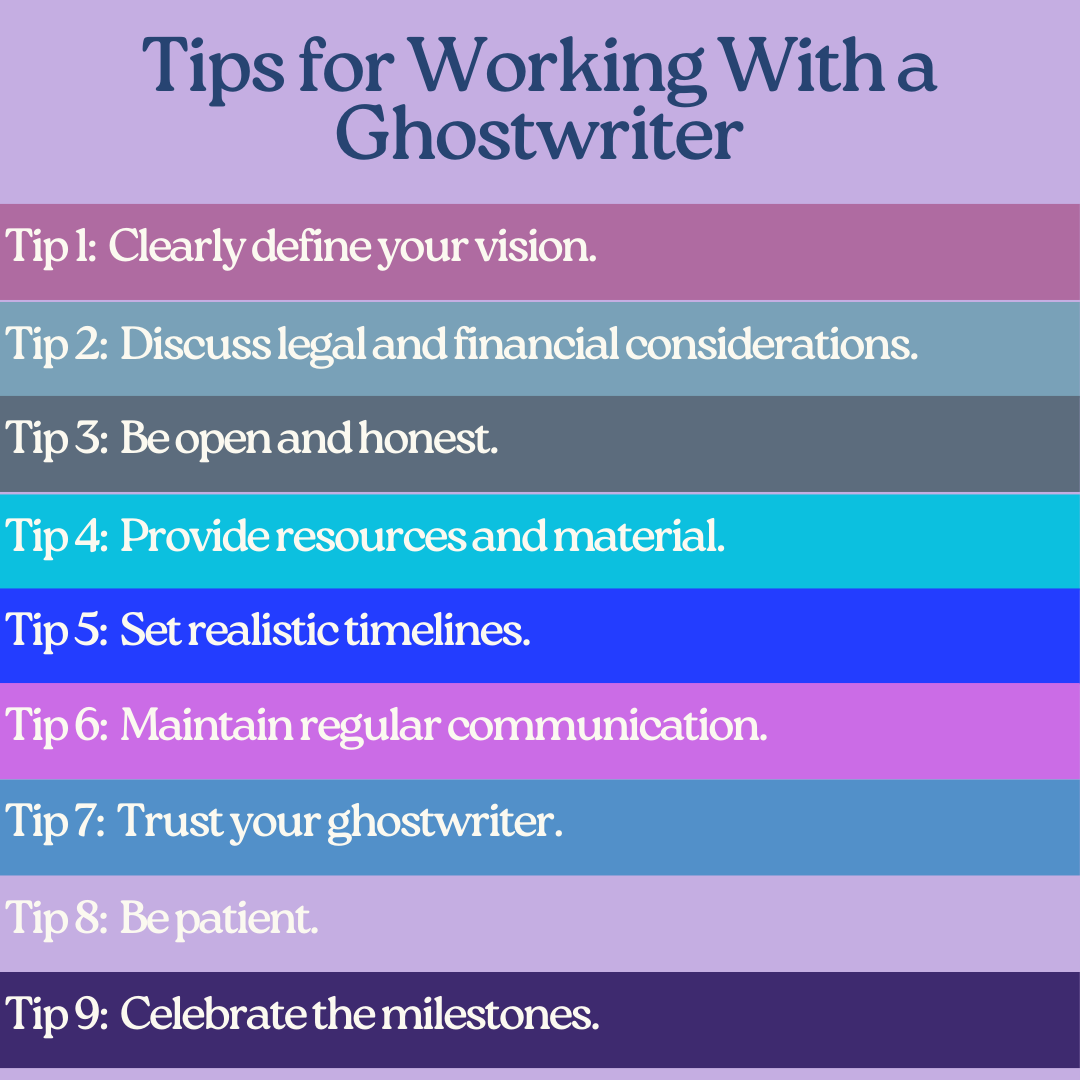Top Tips for Working With a Ghostwriter To Write Your Nonfiction Book
October 14, 2024
Working with a ghostwriter can be an excellent way to bring your ideas and expertise to life. A ghostwriter isn’t just a note-taker; they’re a collaborator who uses their skills to help shape your vision into a finished book. It’s a partnership that thrives on clear communication, mutual trust, and careful planning.
To help you with working with a ghostwriter on your nonfiction book, here are a few tips to ensure a successful collaboration.
9 Tips for Working With a Ghostwriter on Your Nonfiction Book

Tip 1: Clearly define your vision.
Before you begin, it’s crucial to have a clear idea of what you want your book to accomplish. Do you want to preserve family history, share your personal journey, or educate readers on a particular topic? Be as specific as possible. Starting with a realistic and firm sense of purpose makes the process so much smoother.
Your ghostwriter can also help you with this step. “They have the experience and can offer valuable suggestions,” says Jennifer Rizzo, a Colorado-based writer with TWFH, adding, “They will be able to recommend things you may not have considered.”
In addition, if there is an author with a writing style you admire or perhaps a book similar to what you envision, don’t be afraid to share it with your ghostwriter. Having tangible examples can help them better understand the tone, structure, or style you’d like for your book.
Tip 2: Discuss legal and financial considerations.
The last thing you want is for you or your ghostwriter to be unhappy with the partnership due to unclear expectations. That’s why, before any writing begins, make sure to have a solid contract in place. This agreement should outline the scope of work, payment terms, deadlines, and confidentiality clauses.

In addition, it’s a good idea to discuss how credits will be attributed—some ghostwriters prefer to work anonymously, while others like to be credited as co-authors.
What’s the difference? A ghostwriter remains anonymous, while a co-author is publicly acknowledged for their contribution.
Having a frank discussion about these matters in the beginning can save you a ton of frustration later on.
Tip 3: Be open and honest.
One of the key ingredients to a successful ghostwriting project is openness. Sharing your life experiences and ideas fully with your ghostwriter can feel daunting, but it will enable them to capture your authentic voice. “Be as open and honest as you can,” advises Rizzo. “The ghostwriter may be doing the actual writing, but the content of your book is coming from you.”
The more your ghostwriter knows about you and your life, the better they can capture your voice and message. In contrast, Rizzo warns that if you can’t be open and honest with them, developing quality content for your book might be more difficult for your ghostwriter. “The more willing you are to open up and trust your ghostwriter, the better your book will be.”
The best source of information is you. Your ghostwriter will likely need several interview sessions to capture your voice, perspective, and unique insights. This part of the process is essential to creating a book that reflects your story.
That said, if any topics are off-limits, make sure to make it clear from the start. Doing so will save you and your ghostwriter from any awkward moments or misunderstandings later.
Tip 4: Provide resources and material.
Most ghostwriters excel at research and are more than willing to dig into the details. Having a ghostwriter means they take on the bulk of the writing and research, but as the author, your role remains crucial. In the same way that being transparent with your ghostwriter enriches the book, so will sharing all the research and materials you’ve gathered.

The more information you can provide upfront, the stronger your book will be at the end.
“Any information a client can give will help with the personal aspect of the story,” Rizzo notes, adding, “The more a ghostwriter can learn about a client’s life or the lives of their ancestors, the better their book will be.”
Rizzo suggests gathering documents such as family trees, photographs, old journals or diaries, and even military records.
Sharing these tangible materials with your ghostwriter ensures they have access to crucial facts and captivating details.
Tip 5: Set realistic timelines.
It might sound cliche, but writing a book is a marathon, not a sprint. Setting up a timeline that suits both your and your ghostwriter’s schedule, including breaking the project into manageable milestones, is vital in allowing you to stay organized, maintain steady progress, and avoid feeling overwhelmed by the scope of the project.
Rizzo reiterates that each chapter or section of your book may require several rounds of back-and-forth edits that need to be allowed for in your schedule. However, the timeline is very much client-driven. Says Rizzo, “For clients who are highly motivated and have a strict deadline, the timeline is much more set in stone than it is for a client who doesn’t have a deadline and is only able to commit to a couple of hours every other week.”
Nonetheless, don’t rush the process—quality takes time, and a well-paced project is less likely to result in last-minute stress or dissatisfaction.
Tip 6: Maintain regular communication.
Another important tip for working with your ghostwriter is to keep clear and open communication channels.

Rizzo recommends starting with a few meetings between you and your ghostwriter to discuss your goals for the book and give them the information they need.
From there, it’s as simple as staying in the loop by regularly touching base.
“I find that email works really well for sending chapters back and forth and communicating about small details,” says Rizzo, adding that for any big-picture changes or edits, it is best to hop on a call so that your ghostwriter can have a clear understanding of what you want and ask any necessary questions.
Ultimately, regular check-ins will help ensure that you and your ghostwriter have no misunderstandings or miscommunications and keep you reassured and involved in the process.
Tip 7: Trust your ghostwriter.
If you’ve gone and hired a ghostwriter to help you write your non-fiction book, it’s essential that you trust them to do their job. Rizzo agrees: “Clients should never give up on their vision for their book. That said, remember that a ghostwriter is a professional who comes with knowledge and experience.”
Throughout the process, your ghostwriter might suggest changes to enhance the narrative or structure of your book; it’s important to remain open to these ideas. Remember, this is a collaborative effort. While it’s your story, your ghostwriter can use their writing expertise to elevate it and help create something you can be proud of.
Tip 8: Be patient.
After weeks or even months of steady progress, your ghostwriter has finally presented you with the first draft. Exciting! However, before diving in, it’s important to remember that first drafts are seldom perfect. Be ready for the revisions ahead—this phase is essential for refining and polishing the book.

“Writing a book is not a formulaic process,” says Rizzo. “It’s a collaboration of efforts between the author and the ghostwriter.”
She adds that the process of drafting chapters, reviewing, providing feedback, and making edits can sometimes take several rounds before it’s right. “Some chapters may move quickly, while others may take a lot longer. The important thing to remember is that the end goal is to have a book that encapsulates your vision.”
Tip 9: Celebrate the milestones.
Sometimes, though, the process of writing a book can begin to feel long and tedious, which is why it’s so important to celebrate important milestones. For Rizzo, these little celebrations are a way to be reminded that the project is moving along and progressing well.
“Writing a book is a big commitment, both in energy and time,” she says, adding, “Celebrating the small steps along the way helps keep everyone’s eye on the end goal.”
A few milestones worth taking the time to mark are completing the outline, finishing the first draft, and sending your finished manuscript off to an editor for final edits. Acknowledging these important moments in the process is a fun way to help you and your ghostwriter keep the momentum positive.
Working with a ghostwriter can be a rewarding experience, but it requires clear communication, trust, and a willingness to collaborate. By following these tips, you can create a productive and harmonious partnership, leading to a finished nonfiction book that you can be proud of.































